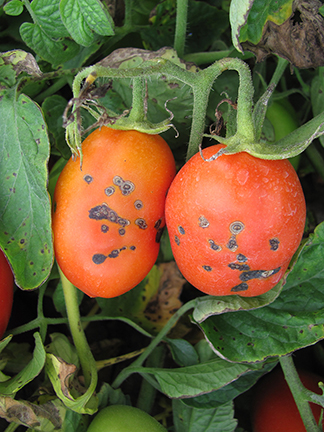Bacterial spot of tomato causes lesions on foliage and fruit of tomato. On leaves, the lesions begin as small water soaked areas and turn into brown lesions with a yellow halo. Lesions on stems often lack a yellow halo. Fruit lesions, which are responsible for direct loss of marketable yield, are often scabby in appearance (Figure 1).
Bacterial spot of tomato is favored by warm, wet weather. The causal bacterium survives on crop debris and may be seed borne. Volunteer tomatoes and peppers may also carry the disease. Transplant greenhouses should be cleaned and sanitized after each generation of transplants is produced.
Management of bacterial spot of tomato has been covered in more detail here https://ag.purdue.edu/arp/swpap/VeggieDiseasesBlog/Lists/Posts/Post.aspx?ID=31. The Midwest Vegetable Production Guide for Commercial Growers 2015, also has recommendations. In this article, however, I would like to discuss a new product that has recently been labeled for this disease. Quintec® has been labeled for several years for powdery mildew on various crops. Evidence has been produced that Quintec® has some efficacy to reduce the severity of bacterial spot. Recently, this product was issued a 2ee. While Quintec® will not solve our bacterial spot problems, used with other products, it may help. Importantly, the efficacy of Quintec® does not depend on whether the strain of the bacterium is copper resistant or not. That is, used properly, Quintec® should help to manage strains of bacterial spot that are copper resistant.
The 2ee bulletin gives the rate of 6 fl oz per gallon in no less than 30 gallons of water per acre. Quintec® must be alternated with other products recommended for management of bacterial spot. When more than one application of Quintec® is made per season, at least one of the applications must be a tank mix with another product effective against bacterial spot. No more than four applications can be made per season if powdery mildew is present.
Many more restrictions and details are listed on the 2ee bulletin, which must be in possession of the grower when Quintec® is applied. One must also be in possession of the regular label when applications are made. The supplemental and regular labels should be available wherever Quintec® is sold. Contact me for details, questions, or a label.
